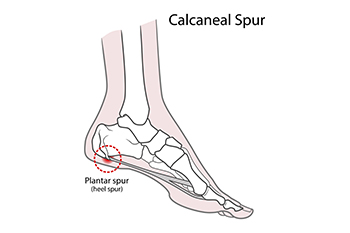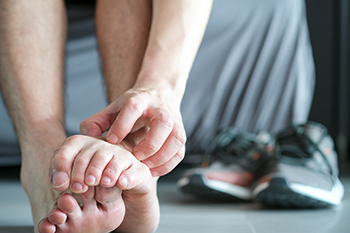Items filtered by date: May 2025
Let the Expert Treat Your Ingrown Toenails
Are Heel Spurs Causing Your Heel Pain?

Heel spurs are bony growths that form on the underside of the heel bone, often due to long-term strain on foot muscles and ligaments. They commonly develop along with plantar fasciitis, especially in people who spend a lot of time on their feet, wear unsupportive shoes, or have flat feet or high arches. Symptoms include sharp, stabbing pain in the heel, especially when standing up in the morning or after sitting for a long period of time. While heel spurs themselves may not always cause pain, the inflammation around them often does. The area may feel tender or appear swollen. A podiatrist can diagnose heel spurs with a physical exam and X-rays. Treatment options include stretching exercises, orthotic inserts, anti-inflammatory medications, and cortisone injections. Surgery is rarely needed, but may be considered in severe cases that do not respond to conservative care. If you have ongoing heel pain, it is suggested that you schedule an appointment with a podiatrist who can accurately diagnose and treat heel spurs.
Heel spurs can be incredibly painful and sometimes may make you unable to participate in physical activities. To get medical care for your heel spurs, contact Ankita Patel, DPM from All Pro Foot and Ankle. Our doctor will do everything possible to treat your condition.
Heels Spurs
Heel spurs are formed by calcium deposits on the back of the foot where the heel is. This can also be caused by small fragments of bone breaking off one section of the foot, attaching onto the back of the foot. Heel spurs can also be bone growth on the back of the foot and may grow in the direction of the arch of the foot.
Older individuals usually suffer from heel spurs and pain sometimes intensifies with age. One of the main condition's spurs are related to is plantar fasciitis.
Pain
The pain associated with spurs is often because of weight placed on the feet. When someone is walking, their entire weight is concentrated on the feet. Bone spurs then have the tendency to affect other bones and tissues around the foot. As the pain continues, the feet will become tender and sensitive over time.
Treatments
There are many ways to treat heel spurs. If one is suffering from heel spurs in conjunction with pain, there are several methods for healing. Medication, surgery, and herbal care are some options.
If you have any questions, please feel free to contact our office located in Swedesboro, NJ . We offer the newest diagnostic and treatment technologies for all your foot care needs.
Common Causes of Itchy Feet

Itchy feet can be an irritating and persistent problem with several possible causes. Skin conditions like psoriasis and eczema often lead to redness, flaking, and intense itching. These conditions may become worse with heat, moisture, or irritation from certain fabrics. Athlete’s foot is a fungal infection that thrives in warm, damp environments like shoes and locker rooms, often leading to peeling, burning, and itching between the toes. Dry skin, especially in cooler weather, can also cause itching and discomfort, sometimes leading to small cracks or rough patches. Another possible cause of itchy feet is peripheral neuropathy, a condition that affects the nerves and can cause unusual sensations. If your feet itch, it is suggested that you consult a podiatrist who can determine the cause and offer effective relief and treatment remedies.
Foot Pain
Foot pain can be extremely painful and debilitating. If you have a foot pain, consult with Ankita Patel, DPM from All Pro Foot and Ankle. Our doctor will assess your condition and provide you with quality foot and ankle treatment.
Causes
Foot pain is a very broad condition that could be caused by one or more ailments. The most common include:
- Bunions
- Hammertoes
- Plantar Fasciitis
- Bone Spurs
- Corns
- Tarsal Tunnel Syndrome
- Ingrown Toenails
- Arthritis (such as Gout, Rheumatoid, and Osteoarthritis)
- Flat Feet
- Injury (from stress fractures, broken toe, foot, ankle, Achilles tendon ruptures, and sprains)
- And more
Diagnosis
To figure out the cause of foot pain, podiatrists utilize several different methods. This can range from simple visual inspections and sensation tests to X-rays and MRI scans. Prior medical history, family medical history, and any recent physical traumatic events will all be taken into consideration for a proper diagnosis.
Treatment
Treatment depends upon the cause of the foot pain. Whether it is resting, staying off the foot, or having surgery; podiatrists have a number of treatment options available for foot pain.
If you have any questions, please feel free to contact our office located in Swedesboro, NJ . We offer the newest diagnostic and treatment technologies for all your foot care needs.
The Importance of Wearing the Right Shoe Size

Wearing the correct shoe size is essential for maintaining foot health and preventing a range of painful conditions. Shoes that are too tight or too loose can lead to serious problems over time. Wearing ill-fitting footwear may contribute to peripheral neuropathy by adding pressure to nerves, especially in individuals with existing health concerns. Corns can form as the skin thickens to protect against friction, while hammertoe may develop when the toes are forced into unnatural positions. Ingrown toenails are another common result, often caused by shoes that squeeze the toes together. Each of these issues can interfere with walking, cause discomfort, and increase the risk of infection. Selecting properly fitted shoes supports comfort, alignment, and long-term foot function. Regular sizing checks are also important as feet can change over time. If you have foot pain from wearing incorrectly sized shoes, it is suggested that you contact a podiatrist who can treat various foot conditions, and provide further guidance on how to buy shoes that fit properly.
Finding a properly-fitting shoe is important in reducing injuries and preventing foot problems. For more information about treatment, contact Ankita Patel, DPM from All Pro Foot and Ankle. Our doctor will treat your foot and ankle needs.
Proper Shoe Fitting
A common concern when it comes to foot health, having properly fitted shoes can help prevent injuries to the foot. Out feet affect our posture and gait, which in turn affects the biomechanics and overall bodily structure. With 33 joints, 26 bones, and over 100 ligaments, the potential for serious injury is much greater than one realizes. Although the feet cease growth in adulthood, they still change shape as they mature. Here are some factors to consider when it comes to investing in proper fitting shoes:
- Be sure the shoes fit correctly right away
- Ensure the ball of your foot fits comfortably in the widest portion of the shoes
- Even though they may look fashionable, improper fitting shoes can either create adverse conditions or exacerbate existing ones you may already have
- Walk along a carpeted surface to ensure the shoes comfortably fit during normal activity
Keeping in mind how shoes fit the biomechanics of your body, properly-fitting shoes are vitally important. Fortunately, it is not difficult to acquire footwear that fits correctly. Be sure to wear shoes that support the overall structure of your body. Do your feet a favor and invest in several pairs of well-fitted shoes today.
If you have any questions, please feel free to contact our office located in Swedesboro, NJ . We offer the newest diagnostic and treatment technologies for all your foot care needs.
Older Adults and Pickleball Injuries

As pickleball continues to gain popularity, especially among adults over 50, so do related injuries. The fast pace and sudden directional changes of the game place stress on muscles, joints, and tendons, particularly in players who may be returning to sports after years of limited activity. Epidemiological data shows a steady increase in pickleball-related injuries, with strains and sprains being the most common. Ankles are frequently affected, often due to quick pivots or inadequate warm-up. While many injuries are mild, some may lead to chronic pain or reduced mobility if not properly addressed. Wearing supportive footwear, proper technique, and flexibility exercises can help reduce risk. If you have experienced foot or ankle discomfort or limited movement after playing pickleball, it is suggested that you see a podiatrist for a diagnosis and appropriate treatment.
Ankle and foot injuries are common among athletes and in many sports. They can be caused by several problems and may be potentially serious. If you are feeling pain or think you were injured in a sporting event or when exercising, consult with Ankita Patel, DPM from All Pro Foot and Ankle. Our doctor will assess your condition and provide you with quality foot and ankle treatment.
Common Injuries
The most common injuries that occur in sporting activities include:
- Achilles Tendonitis
- Achilles Tendon Rupture
- Ankle Sprains
- Broken Foot
- Plantar Fasciitis
- Stress Fractures
- Turf Toe
Symptoms
Symptoms vary depending upon the injury and in some cases, there may be no symptoms at all. However, in most cases, some form of symptom is experienced. Pain, aching, burning, bruising, tenderness, tightness or stiffness, sensation loss, difficulty moving, and swelling are the most common symptoms.
Treatment
Just as symptoms vary depending upon the injury, so do treatment options. A common treatment method is known as the RICE method. This method involves rest, applying ice, compression and elevating the afflicted foot or ankle. If the injury appears to be more serious, surgery might be required, such as arthroscopic or reconstructive surgery. Lastly, rehabilitation or therapy might be needed to gain full functionality in the afflicted area. Any discomfort experienced by an athlete must be evaluated by a licensed, reputable medical professional.
If you have any questions please contact our office located in Swedesboro, NJ . We offer the newest diagnostic and treatment technologies for all your foot and ankle needs.

